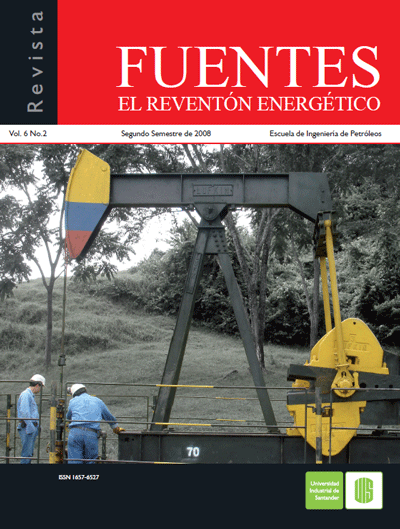PROCESOS DE DESPLAZAMIENTO MISCIBLES Y SU INCIDENCIA EN EL COMPORTAMIENTO DE LA INYECCIÓN DE VAPOR.
Publicado 2008-11-28
Cómo citar
Resumen
RESUMEN
La mayoría de los métodos de recuperación térmica en el mundo han sido aplicados a yacimientos de crudo de alta viscosidad con el objetivo de aumentar la producción de aceite, reduciendo su viscosidad. La inyección de agua es usada generalmente para la recuperación de aceites de peso intermedio y la inyección continua de vapor para crudos medianos a pesados. Durante la inyección continua de vapor actúan varios mecanismos para lograr la recuperación efectiva del aceite. En este artículo son analizadas especialmente los relacionados con la destilación de los componentes livianos del crudo.
La inyección continua de vapor es técnicamente diferente de la inyección de agua, no solo por las evidentes diferencias en las condiciones físicas del fluido que está siendo inyectado, sino también por los mecanismos microscópicos de recuperación involucrados. En realidad, la diferencia principal radica en el efecto que produce la condensación del vapor de agua, que al cambiar de fase arrastra consigo los componentes más volátiles del crudo generando así un pequeño frente de miscibilidad con el aceite original del yacimiento.
Cuando ocurre la destilación de los componentes más livianos del crudo, el objetivo principal del proceso destilación no es la reducción de la viscosidad sino el reducir la saturación de aceite residual por debajo de la que se obtiene con la inyección de agua ordinaria. En este artículo es realizada una descripción detallada del proceso y son transmitidos los trabajos realizados en laboratorio para identificar la existencia de este mecanismo hasta el momento.
Palabras clave: Inyección continua de vapor, inyección de agua, destilación, recobro mejorado, condensación.
ABSTRACT
Most of the thermal recovery methods in the world have been applied to reservoirs of highly viscous crude oil with the purpose of increasing oil production by reducing its viscosity. The injection of water is generally used for the recovery of light and intermediate weight oil and continuous steamflooding for medium to heavy crude oil. During steam injection there are several mechanisms that ensure effective recovery of oil. In this article are discussed especially those related to the distillation of the lighter components of crude oil.
Continuous steamflooding is technically different from waterflooding, not only for the obvious differences in the physical conditions of the fluid being injected, but also for the recovery of microscopic mechanisms involved. In fact, the main difference lies in the effect produced by condensation of water vapor, that when changing phase drags with it the most volatile components of crude generating a small front of miscibility with the original oil.
When distillation of the lighter components of crude oil occurs, the main objective of the distillation process is not viscosity reduction, but the reduction of residual oil saturation at lower levels than that obtained with the injection of water. In this article a detailed description of the process is made and the experiments made at laboratory to identify the existence of this mechanism are transmitted.
Key words: Steamflooding, Waterflooding, distillation, enhanced oil recovery, condensation.
